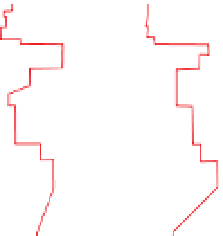Geoscience Reference
In-Depth Information
a)
a)
Thorium
K (%)
U (ppm)
Th (ppm)
7.0
8.0
5.0
8.0
0.0
0.3
0.6
0.9
0.0
0.6
1.2
1.8
0.0
4.0
8.0
12.0
3.0
1.5
Soils
1.5
5.0
Base of
weathering
Clays
1.0
3.0
3.0
Clay with rock fragments
1.5
Saprolite
3.0
Very weathered
Slightly weathered
Fresh
b)
Potassium
1.3
0.7
1.4
0.9
Depth
0.2
b)
2.0
1.6
2.0
K (%)
U (ppm)
Th (ppm)
1.2
Base of
weathering
0.0
1.0
2.0
3.0
0.0
1.0
2.0
3.0
0.0
8.0
16.0 24.0
3.0
5.3
0.0
3.1
Soil
2.0
0.5
4.5
Weathering
profile
1.0
0
200
Metres
Andesite
Soil
Fresh
rock
1.5
Mafic monzonite
Qtz monzonite (K-altered)
Potassic alteration
Phyllic alteration
2.0
Depth
(m)
Figure 4.19
Summary of K and Th concentrations in the vicinity of
the Goonumbla
Au porphyry deposits. Variation
in (a) eTh (in ppm) and (b) K (in %). Redrawn, with permission,
from Dickson and Scott (
1997
).
-
North Parkes Cu
-
Figure 4.18
Variations in radioelement concentrations in the
soil/regolith pro
le. (a) Radioelement concentrations through the
weathering pro
le of a basalt in Victoria, Australia; (b) in a soil
pro
le overlying an adamellite in New South Wales, Australia.
unaffected by alteration, U is slightly depleted and
K content is signi
cantly increased. The K/Th ratio is
shown to be mostly greater in altered rocks than in their
unaltered equivalents owing to pervasive adularia and illite
alteration at the core of the alteration zones. The degree of
K enrichment decreases with distance from the mineralised
veins. Examples of the radiometric responses of this area
are described in
Section 4.7.3.2
.
The correlation between potassium content and degree
of alteration at the Iron King massive Pb
consistent, but Th is greater in the altered rocks and even
more so in the weathered zone and overlying soil. Clearly,
the depth of weathering critically affects the radiometric
response of the mineralisation, the deposit coinciding with
a K-poor zone if weathered and a K-rich zone if unweath-
ered material is exposed. Again, the near-surface environ-
ment is shown to be of vital importance to radiometric
responses
A style of mineralisation for which some very strong
alteration-related radiometric responses have been reported
is epithermal gold
-
-
-
-
Ag
sulphide deposit in Arizona, USA, is demonstrated in
of about 4, and occurs in micas associated with sericitic
alteration.
Zn
Cu
Au
silver deposits. Intense hydrothermal
alteration is usually associated with potassium enrichment.
The levels of U and Th are generally not affected, or may be
slightly depleted. Geochemical data from both altered and
unaltered rocks from the Waihi-Waitekauri region in New
Zealand are shown in
Figure 4.20
.
Thorium content is
-
4.7
Interpretation of radiometric data
The reduction of radiometric survey data aims to produce
a
spatial
dataset
that
shows
the
actual
ground




































































Search WWH ::

Custom Search